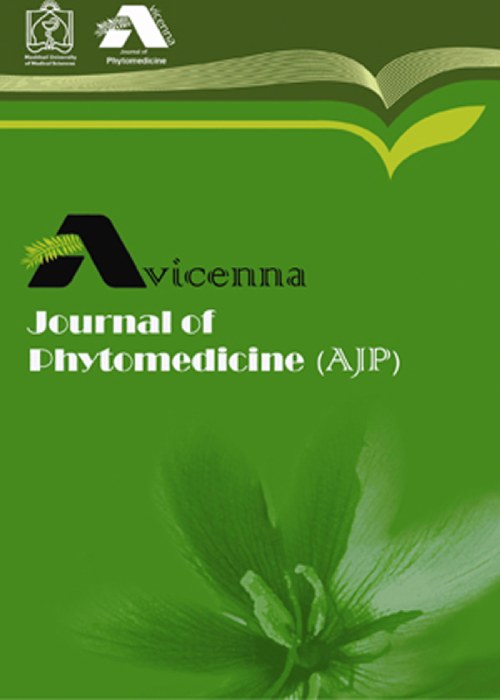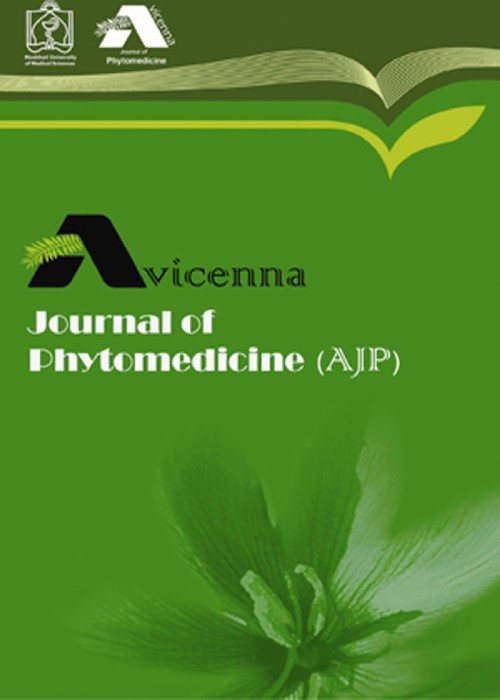فهرست مطالب

Avicenna Journal of Phytomedicine
Volume:13 Issue: 4, Jul-Aug 2023
- تاریخ انتشار: 1402/04/10
- تعداد عناوین: 9
-
-
Pages 328-337Objective
Echium amoenum and Hypericum perforatum dried flowers have been used for therapy of mental disorders in Iranian traditional medicine. In this study, we assessed the efficacy of the E. amoenum and H. perforatum extracts in patients with mild to moderate depression.
Materials and MethodsIn an 8-week double-blind, parallel-group trial, 51 patients randomly consumed 20 mg of fluoxetine or 350 mg of herbal medicine twice daily. The Hamilton Rating Scale for Depression (HAM-D) was used to assess depression severity in patients at weeks 0, 4, and 8.
ResultsAccording to the Hamilton score, there were no significant differences between the fluoxetine- and herbal medicine-treated groups after 4 and 8 weeks (p>0.05). Dry mouth was the only reported side effect which was significantly lower in the herbal group (p<0.05) in weeks 2 and 4.
ConclusionE. amoenum and H. perforatum have anti-depressant properties similar to fluoxetine and they can be used to treat depression as an alternative to fluoxetine.
Keywords: Anti-Anxiety Drug, Fluoxetine, Depression, Herbal Drug, Traditional Medicine -
Pages 338-353Objective
This study was performed to provide an updated systematic review of herbal medicines and phytochemicals used for treatment of the pediatric patients with attention-deficit/hyperactivity disorder (ADHD).
Materials and MethodsInternational electronic databases, including Scopus, PubMed, ScienceDirect, and Google Scholar were investigated from 1st January 2000 to late October 2021. Interventional studies published in English language, including randomized controlled trials (RCTs) or open-label clinical studies, which evaluated the effect of herbal medicines and phytochemicals on pediatric ADHD were included in this review.
ResultsFifteen studies met the inclusion criteria. Several pieces of evidence support the efficacy of Ginkgo biloba L. and Pycnogenol; mainly inconclusive evidence could be found for Valeriana officinalis L., Melissa officinalis L., and ginseng. The results showed that while Hypericum perforatum L. was ineffective for ADHD, Passiflora incarnata L., Crocus sativus L, and Prunus dulcis (Mill.) D.A.Webb had similar efficacy compared to methylphenidate (MPH).
ConclusionA number of herbal medicines appear to be relatively safe and provide potential efficacy in amelioration of ADHD. However, due to lack of adequate reports of RCTs, no definitely specific recommendations could been made so far.
Keywords: ADHD, Attention-deficit, hyperactivity disorder, Pediatric, Herbal Medicine, Systematic review -
Pages 354-376Objective
This review describes the antioxidant activity of flavonoids as a subgroup of polyphenols and a partial or entire substitute for synthetic antioxidants.
Materials and MethodsAll relevant databases were searched using the terms “Phytochemical”, “Polyphenol”, and “Flavonoid”.
ResultsThe oxidative reaction caused by free radicals is a reason for food spoilage, which causes unpleasant odor, loss of taste, and damaged tissues. The common antioxidants employed in foods include butylated hydroxyanisole, butylated hydroxytoluene, propyl gallate, and tert-butyl hydroquinone. Despite their high efficiency and potency, synthetic antioxidants have adverse effects on the human body, such as causing mutation and carcinogenicity. A whole and a group of them known as polyphenols possess high antioxidant activity. These compounds are potential antioxidants due to their capabilities such as scavenging free radicals, donating hydrogen atoms, and chelating metal cations. The antioxidant mechanism of action of flavonoids is transferring hydrogen atom to free radicals. Accordingly, the more the flavonoid structure makes the hydrogen transfer faster and easier, the more the flavonoid’s antioxidant power will be. Therefore, the antioxidant activity of the flavonoids with hydroxyl groups in their structure is the highest among different flavonoids.
ConclusionIn addition to health promotion and some disease prevention effects, various in vitro investigations have indicated that flavonoids possess high antioxidant activity that is comparable with synthetic antioxidants. However, to be commercially available, these compounds should be extracted from a low-price source with a high-performance method.
Keywords: Antioxidant, Flavonoids, Food preservation, Phytochemical, polyphenol -
Pages 377-387ObjectiveMethotrexate (MTX) is a frontline antimetabolite anticancer drug which is used in different cancer treatments but its nephrotoxicity is a notable drawback that limits its clinical use. The present study was undertaken to examine whether Datura stramonium leaf extract (DSLE) could block MTX nephrotoxic side effect in rats.Materials and MethodsAnimals were divided randomly into Control, Ethanol extract, MTX, and Extract + MTX groups. DSLE (200 mg/kg bw) was orally administered for 21 days, while MTX was injected intraperitoneally (ip) on the 18th day. Serum levels of urea, creatinine and uric acid were determined. Kidney samples were used to determine glutathione peroxidase (GPx), superoxide dismutase (SOD), and catalase (CAT) activities, and renal levels of malondialdehyde (MDA), reduced glutathione (GSH), nitric oxide (NO), interleukin-6 (IL-6), tumor necrosis factor-α (TNF-α) and caspase-3.ResultsInjection of MTX resulted in considerable increases (p<0.05) in creatinine, urea, and uric acid levels as well as renal MDA, NO, IL-6, TNF-α and caspase-3 compared to the controls. SOD and GPx increased significantly, while GSH was significantly depleted. Interestingly, DSLE markedly reduced (p<0.05) levels of creatinine, urea, uric acid, TNF-α, NO, MDA and caspase-3, whereas renal GSH increased markedly compared to the MTX group.ConclusionDSLE has nephroprotective activity against MTX toxicity. However, further mechanistic studies are needed.Keywords: Methotrexate, Inflammation, Antioxidants, Apoptosis, D. stramonium
-
Pages 388-399ObjectiveThis study was designed to detect the therapeutic effects of galbanum oil plus dry cupping (a Persian medicine-based method) in hospitalized patients with coronavirus disease-2019 (COVID-19).Materials and MethodsIn this randomized controlled trial, 60 hospitalized COVID-19 patients with positive polymerase chain reaction test (PCR), pulmonary involvement and blood oxygen saturation (SpO2) ≤93 mmHg, were randomly assigned into two groups to take the standard therapeutic regimen alone or alongside cupping and topical galbanum oil (Ferula gommosa oleo-gum resin) for 3-5 days. The SpO2 level, the severity of signs and symptoms of patients and laboratory parameters were compared between the two groups.ResultsFifty-eight patients were analyzed. The SpO2 level changed from 89.27±3.82 to 90.29±3.09 mmHg (p=0.038) in control group, while it increased from 88.74±3.45 to 94.23±2.1 mmHg (<0.001) in galbanum group with a significant difference between the groups (p<0.001). Fever, cough, dyspnea, and anorexia alleviated in the galbanum group more than the control (p=0.003, 0.001, 0.01, and 0.04, respectively). No adverse effects were reported due to galbanum oil and cupping therapy.ConclusionDry cupping with galbanum oil alongside the routine therapeutic regimen could be more effective than the routine therapeutic regimen alone for improving SpO2 level and alleviating fever, cough, and dyspnea in COVID-19 patients.Keywords: COVID-19, Cupping therapy, Hijama, Ferula gommosa, Galbanum, Persian Medicine
-
Pages 400-411ObjectiveThe ongoing COVID-19 pandemic has been associated with clinical signs characterized by fever, fatigue and cough. Our study aimed to assess the efficacy of a Persian medicine formulation, lavender syrup, as an add-on to standard care in patients with mild to moderate COVID-19.Materials and MethodsIn this clinical trial which was conducted in Gorgan (Iran), 84 male and female COVID-19 outpatients were randomly allocated to either lavender syrup receiving 9 ml/twice/day for 21 days with standard conventional care or control groups. The primary objectives were to assess the improvement of clinical symptoms, while the secondary objectives were treatment satisfaction and anxiety levels which were evaluated once a week for 3 weeks.ResultsOut of 84 participants, 81 were analyzed (41 in the add-on group). The comparison between groups for cough severity and anosmia showed a higher reduction in the lavender group. The effect size was 0.6 for cough relief. Other symptoms and the Hamilton total score decreased in both groups with no statistically significant differences between the groups. The lavender group showed greater patients’ satisfaction score.ConclusionAdjunctive therapy with lavender syrup could reduce cough and improve the quality of life in patients with COVID-19 patients.Keywords: COVID-19, Cough, Herbal Medicine, Lavandula angustifolia, Persian Medicine
-
Pages 412-428ObjectivePsoriasis is a chronic inflammatory autoimmune disease. The effectiveness of noscapine has been employed as a helpful treatment for various disorders and subjected to recent theoretical breakthroughs.Materials and MethodsPsoriasis-like lesions were induced by topical application of 5% imiquimod (IMQ) (10 mg/cm2 of skin) in male Balb/c mice and then medicated with a single oral dose of methotrexate (MET) as a positive control or daily oral treatment of noscapine (5, 15 and 45 mg/kg). In this way, skin inflammation intensity, psoriatic itchiness, psoriasis area severity index (PASI) score, ear length, thickness, and organ weight were daily measured. At the end of the study, histological and immunohistochemical and enzyme-linked immunosorbent assays (ELISA, for pro-/anti-inflammatory factors) were performed in each ear.ResultsIMQ caused psoriasis-like lesions. Noscapine markedly alleviated macroscopic parameters, namely ear thickness, ear length, skin inflammation, itching, and organ weight, as well as microscopic parameters including, pathology and Ki67 and p53, and tissue immunological mediators, such as tumour necrosis factor (TNF-α), interleukin (IL)-10, transforming growth factor (TGF-β), interferon-g (IFN-g), IL-6, IL-17, and IL-23p19 in the psoriatic skin in a concentration manner (p<0.05-<0.001).ConclusionTherefore, noscapine with good pharmacological properties has considerable effects on psoriasis inflammation.Keywords: Psoriasis, Imiquimod, Inflammation, Noscapine, Methotrexate
-
Pages 429-441ObjectiveCancer stem cells (CSCs) remaining in the tumor tissues after applying treatments may cause recurrence or metastasis of prostate cancer (PC). Curcumin has the promising potential to target CSCs. Here, we aim to evaluate the cytotoxic effects of curcumin on the expression of miR-383-5p and miR-708-5p and their target genes in CD44+ CSCs and CD44- non-CSCs isolated from the PC3 prostate cancer cell line.Materials and MethodsWe used MTT assay to determine the optimal cytotoxic dose of curcumin on CD44± PC cells. Then, we assessed nuclear morphological changes using DAPi staining. We used Annexin V-FITC/PI to quantify apoptotic cell death. qRT-PCR was also used to detect miRNA and gene expression levels after curcumin treatment.ResultsCurcumin significantly enhanced the apoptosis in both CD44- and CD44+ PC cells in a dose-dependent manner (p < 0.05). The cytotoxicity of curcumin against CD44- cells (IC50 40.30±2.32 μM) was found to be greater than that against CD44+ cells (IC50 83.31±2.91 μM). Also, curcumin promoted miR-383-5p and miR-708-5p overexpression while downregulating their target genes LDHA, PRDX3, and RAP1B, LSD1, respectively.ConclusionOur findings indicate that curcumin, by promoting the expression of tumor suppressors, miR-383-5p and miR-708-5p, and inhibiting their target genes, induced its cytotoxicity against CD44± PC cells. We trust that curcumin could be established as a promising adjuvant therapy to current PC treatment options following more research in clinical settings.Keywords: Prostate neoplasms, microRNAs, hsa-miR-708-5p, hsa-miR-383-5p, Natural products, Curcumin
-
Pages 442-453ObjectiveMercuric chloride (Merc; HgCl2) is toxic to humans and animals and contributes to environmental pollution, which usually results in nerve and systemic harm to different organs. Falcaria vulgaris (FV) is a medicinal plant rich in antioxidants. This research aimed to assess the FV hydroalcoholic extract effects on kidney toxicity induced by Merc.Materials and MethodsForty-eight male rats were divided into eight groups: the control group: received saline; the Merc group: received 0.5 ml/day of 0.5 ppm aqueous Merc; FV1, 2, and 3 groups: received 50, 100, 150 mg/kg FV, respectively; and Merc + FV1, 2, and 3 groups: received Merc and FV at three doses. The administration period was 14-days. Subsequently, kidneys and sera were cumulated from each group for the analysis. Samples were analyzed via hematoxylin-eosin staining and biochemical tests.ResultsThe rats that received Merc displayed significant decrement in the kidney index, the diameter of renal corpuscles, total antioxidant capacity levels, superoxide dismutase activity (all, p<0.01), and 150 mg/kg FV mitigated these outcomes (all, p<0.05). Urea, creatinine, nitric oxide, and the level of apoptosis revealed a significant increment in the kidney of the rats that received Merc (all, p<0.01), and 150 mg/kg FV decreased these results. Furthermore, FV ameliorated histological changes induced by Merc (all, p<0.05).ConclusionThe FV hydroalcoholic extract protects the kidneys against Merc-induced nephrotoxicity. Antioxidant and anti-apoptotic FV hydroalcoholic extract properties were involved in this healing effect.Keywords: Antioxidants, Kidney, Mercuric chloride, Nitric oxide, Oxidative stress


